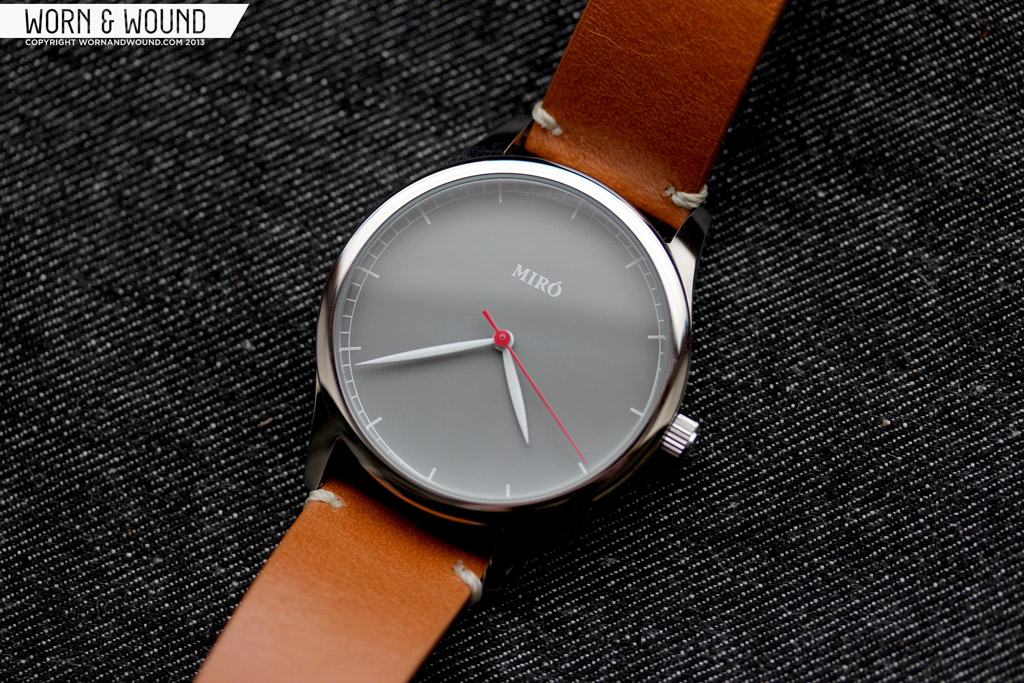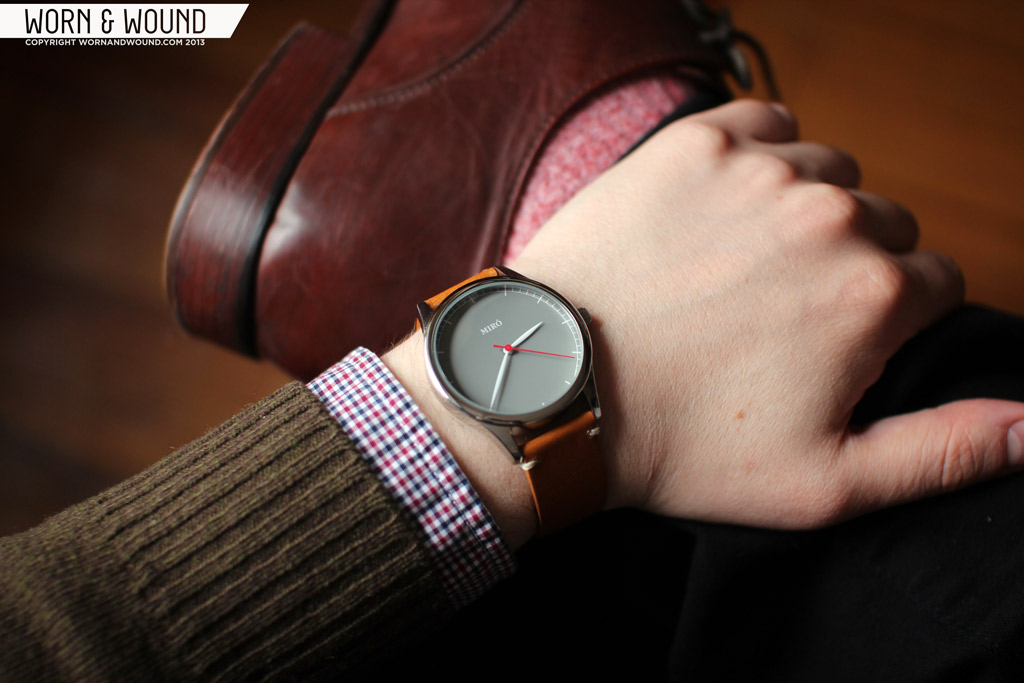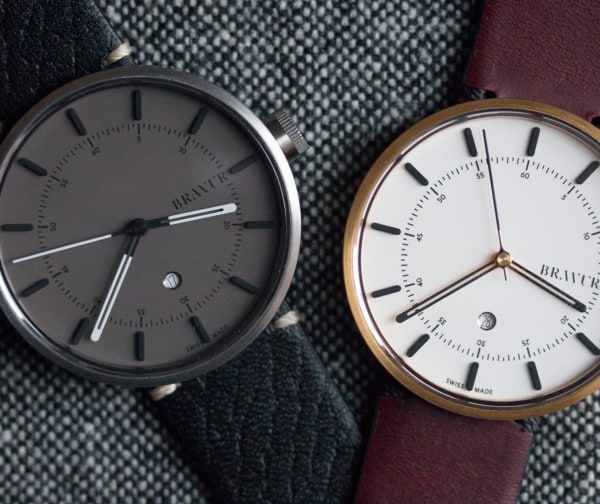Simple is harder to achieve in design. When something lacks bells and whistles it is more vulnerable, easier to pick apart and scrutinize. As such, it is a risk for a brand to pursue something simple and clean. But, when simplicity is achieved, there is an unmistakable beauty that comes along with it. This leads me to the actual topic of this article, a relatively new brand of watches from Sweden, called Miró.
Miró didn’t set out to do something terribly new or innovative, they didn’t use fancy materials or shocking colors, they just made a pure expression of a 3-hand watch that lacks pretention. With a dial design that is sparse, but well balanced, a calf-leather strap that is refined, but basic and hands that add just the slightest bit of contrast, the Miró watches are more about style than substance. One look at their very well directed photography will confirm this. They set out to make a watch that can be worn by anyone and in any situation, and I think stylistically, they succeeded.

And though the Miró is simple, I wouldn’t call it minimal. There is a warmth and expressiveness to the design that is very apparent, and speaks to something more emotional than minimalism.
 Case: Stainless Steel
Case: Stainless Steel
Movement: Miyota Quartz
Dial: Grey
Lume: No
Lens: Domed Mineral Crystal
Strap: Calf Leather
Water Res.: 50m
Dimensions: 40x48mm
Thickness: 10 mm
Lug Width: 20 mm
Crown: 5 x 3 mm screw down
Warranty: 30 day return
Miró was kind enough to send over one of their models for me to take a look at, and I have to say, I was immediately impressed by the look of the watch. I asked for the grey dial with honey strap variation, as that stood out as a bit unique, and indeed it has a distinct personality. The watch features a 40 x 48 x 8.5 (10 w/ crystal) mm polished stainless steel case with a domed mineral crystal. There is nothing too special about it to report, but it is elegant enough and works with overall design. The watch feels very thin and light, which is largely do to the Miyota Quartz movement inside, making it comfortable and easy to wear. The domed mineral crystal is a nice touch that adds a bit of a vintage charm to the design.
The Miró has an interesting dial that is probably hit or miss for some. It has a simple single white index running around its perimeter that consists of large and small hash marks and a thin line. It is so far to the edge that at some angles the index is obscured by the case itself. What it amounts to is a very open and unadorned dial. The amount of pure open space is uncommon, but I don’t find it boring or dull. It’s more… calm than anything else. And despite being so open, feels balanced and well though out. If the markers had come in further, they would have been too aggressive, if there had been numerals, the dial would have become generic. In the end, it just works.
The grey of the dial is fairly light, and is made lighter by the white index and leaf hands. The only thing that stands out on the dial is the red seconds hand, which adds just a touch of something more youthful and energetic to the watch. Moreover, the grey is an attractive color that I have not seen on a watch of this type before. It looks great against the polished steel case, and matches perfectly with the strap.
Speaking of which, the strap is a highlight of the watch. It’s a 20mm calf leather strap, made out of a rigid, but thin, bridal-type of leather. It’s clearly leather that will age very well, softening and gaining patina. The styling of the strap is also very simple; it tapers slightly, has inked edges and two cream color stitches by the lugs, which is a classic way to finish it off. On the wrist, it’s very comfortable, and more importantly, looks fantastic. The leather has a bright rich color that is incredibly appealing and really ties the watch together.
What the Miró succeeds at best is being a great accessory. Its style compliments everything around it, and it seems to fit in with anything. It looks sharp against colorful gingham, yet sporty with a t-shirt. And despite its subtlety, it is a watch that has a lot of wrist presence. Naturally, my only let-down is that I would prefer it were an automatic, but to keep the price under $200, and perhaps make it more appealing as a unisex watch, I understand the use of quartz. Needless to say, a $450 – $500 automatic version would be a great option as well. In the end, I think the Miró is a very enticing extra watch for the style-centric and a great gift for a young collector…and as a side note, gents, this watch has been noticed and complimented by more women than most, if not all, of my fancier mechanical watches…
The Miró watches are currently available with 3 dials colors (crème, black and grey) and 3 strap options (honey, chocolate and natural) for a total of 9 varieties, all powered by Miyota quartz movements. The watch is available on-line for $195.
Sample unit supplied by Miró Watches
By Zach Weiss









 Featured Videos
Featured Videos











I think you hit the nail on the head, particularly with regards to an auto version. A 38mm version wouldn’t be bad either.
I can see it now, a $400, 38mm, auto version with sapphire crystal. I don’t see any reason why it wouldn’t be possible to do with a Miyota 9015.
wait wait wait, $195 for a 3-hand miyota quartz movement in a off-the-shelf case with a mineral crystal?
Seriously? The most valuable part of that watch is the strap. It should be priced closer to $50-80.
Hi,
Thanks for the comment. That would really only be true if they were a very large brand making large quantities. They’re not, and to charge so little would also devalue the product. While the components alone might not add up to final cost (they don’t on any product anywhere) the price is fair for a well-styled watch… I mean, under $200 is still very very cheap in the watch world.
-w&w
I don’t know. the watch is nice, but I believe the price is out of this world. too.
with $232 you can get basically the same looking watch (strap color aside) with an automtic myota movement and a deployant buckle
http://tinyurl.com/cp93owu
and they’re not this big maison with an household name to justify such a high price differential than the DIY watches from fewsome.com
Nah. The dials on Fewsome watches are dot-matrix printed, and there have been a lot of quality complaints. They’re basically a novelty item. Definitely a case of “you get what you pay for.”
With the Miro, you’re paying for a design concept and commercially acceptable construction and quality control.
Not saying I’m going to run out and buy a Miro, but the comparison is apples and oranges.
A fine Watch-intelligent to include the Blond. The Miro and Tsovet great looking but lacking an autimatic mov’t a definite negative irregardless of Swiss or Myota otherwise would purchase.
Another great looking watch ruined by a quartz movement.
The Maratac Pilot is ~200-240 (with sapphire,not mineral), and the Cadence Ecomatic can be had for ~80 new. Both have Miyota autos. Both are ’boutique’. This has neither sapphire nor auto, and costs 2.5x what the Cadence does.
Just got my Grey Miro. Nice watch!
Worth every bit of money I spent on it and supporting start ups is always good.
How long did it take to arrive?